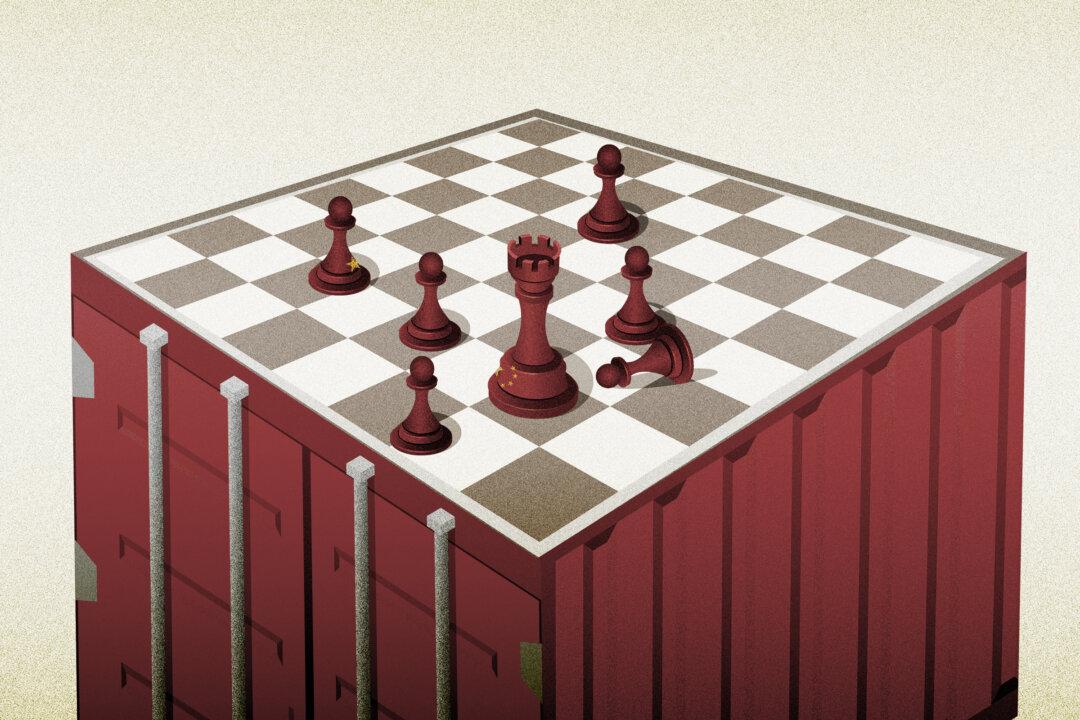The company that has for decades been seen as making sturdy accessories and tools to last a lifetime, now wants its customers to heed the call of adventure with a watch. Victorinox, the company behind the iconic Swiss army knife, showcased its latest timepieces at Baselworld.
The brand’s highly durable I.N.O.X. line of watches that was first introduced in 2014, took three years to develop because the watches had to go through 130 strength tests to prove their durability and reliability under extreme situations.
Alexander M. Bennouna, CEO of Victorinox Swiss Army Watch SA, spoke to Epoch Times at Baselworld about the new timepieces, his goals for the watch line, and the future of the brand. The interview has been edited for length and clarity.
Epoch Times: What are your expectations for the watch line?
Alexander Bennouna: Victorinox exists for more than 130 years. It was a mono-product brand for 115 years. So the diversification of the brand is very recent. And it was a strategic decision by the group’s chairman in order to maintain the sustainability of the business.
Since economically it is not a very favorable period, having a multiproduct portfolio is much easier than depending on just one product. So this stimulated the diversification a few years ago.
I joined the organization 12 years ago, at a time when Victorinox was predominantly focusing on the North American market. And my role was in international distribution at the time. I took over the leadership of Victorinox in 2007, with the mission to make sure the word Victorinox is more than just a few letters on the dial, but actually means something.
130 Strength Tests
Victorinox’s Swiss army knife is known for quality, functionality, innovation, and iconic design. We are not a watch brand but a Swiss brand making watches.
If we make Swiss watches like all the other watch brands that have been doing very well for centuries and decades, what’s the point? Absolutely there is no benefit. We would just be another watch on the counter and that’s it.
In 2006 and 2007 we started to invest a lot in the homologation process to improve the quality of our watches.
At the end, our business partners recognized that the quality of our watches is amazing. They are superior to many other brands.
Watchmakers, distributors, and retailers knew it. But the end consumers were not aware of it. Improving the quality was not enough. We had to come up with a new standard.
And this is how we introduced the I.N.O.X. watch in 2014, which is a timepiece that was subject to 130 strength tests. It took three years to develop the watch because of the tests.
We took all the homologation tests from the Swiss watch industry, including the military homologation tests. We did some crazy tests, like a 10-metre drop, pressure, and so on. We looked at what is the heaviest engine around us and realized that it’s a 64-ton Leopard tank. We said let’s drive over the watch. It has to resist to that pressure. Then, we tested it in a washing machine.
This is how we tested the watch and re-engineered it. It took us three years. We finally came up with a quality standard that is superior to anything on the market. So the first step was to communicate this value to the end consumer.
Communicating the Value
Epoch Times: How do you communicate this value? How do you tell the story?
Mr. Bennouna: We predominantly use online, social media. Because we would like to reach out directly to the end consumer and connect directly with the consumer. Since we’re coming with a new quality standard, a new story, we needed an alternative way to communicate that to the audience.
This year, we have the story of the I.N.O.X. diving versions and other models.
There is another value, which is very important to Victorinox. It’s called functionality. You take a Swiss army knife, you open different blades and they perform different things. So, it is this kind of idea. And this is where we are making the first step this year.

The diving watch took us two years to develop, as it’s really a quality driven design. We had to rethink everything to come up with a diving watch that is I.N.O.X. We integrated all of the homologation tests for Swiss diving watches.
And talking about functionality, we have this bumper that can help you protect watches against scratches. It offers a magnifying glass as well. We came up with a set of accessories like the strap and bumper. And with each set, you can make 24 different identities for each watch.
Different DNA, different personalities, and that’s how we approach the idea of functionality. Bringing new function and new life to your watch.
Every Day’s Adventure
Epoch Times: Can you tell us your marketing and communication strategy?
Mr. Bennouna: When we first launched the I.N.O.X., we communicated the tests. It was very important to communicate that the watch resists all sorts of pressure, drop tests, and so on.
This year, we are trying to align a little bit more with the global brand approach, which says “every day’s adventure.”

Epoch Times: It was a companion for life before, right?
Mr. Bennouna: It was. We changed it to “every day’s adventure.”
For example, we put the diving watch on ice on top of a Swiss lake in the mountain, which is a little bit unconventional. But at the same time, we can really illustrate the strength and the resistance of the watch.
Epoch Times: What inspired you to change “companion for life” to “every day’s adventure?”
Mr. Bennouna: We are not selling watches, we are selling a consumer experience. So the most important thing for us is that this consumer experience speaks the same language, whether we talk about the Swiss army knife, or the watch, or the luggage.
Don’t Leave the Planet Without It
There was a story of an astronaut that Mr. Elsener, the owner of the group, loves to tell. A Canadian astronaut, who went to the Mir space station, used a Swiss army knife to enter the station because it was locked too strong. He came with this advice: “Never leave the planet without a Swiss army knife.”
So it’s exactly the same philosophy, and the same approach we would like to have for our watches. For example, we introduced the I.N.O.X. paracord strap last year, with a limited edition of 5,000 units. This paracord is the same paracord used by the parachutes in the U.S. Army, so it has a resistance level of 250 kg [550 pounds].
This is a rescue tool. You have several strings inside. With these paracord strings, you can make a fishing net, you can make shoelaces, and so on.
So if you have this rescue tool on your wrist and the Swiss army knife in your pocket, you’re equipped with everything. You just need to be a little bit talented.
Special Market: North America
Epoch Times: In terms of your global business, where do you see strong potential?
Mr. Bennouna: Switzerland is our strong market. Most people who visit Switzerland buy Swiss army knives. That’s why Switzerland is the No.1 market for Swiss army knives. And knives represent 50 percent of the overall sales.
In terms of watches, we are very strong on the American continent from North to South. The U.S. is our No.1 market. The U.S. market is a different story because we started with the Swiss Army as a brand. And now it is Victorinox Swiss Army brand.
And this year, one of the regions where we expect to have the fastest growth will be Europe.
Epoch Times: Why Europe?
Mr. Bennouna: We are redeploying in France and Italy. And we have a very strong development in Germany.
We are present in most of the important markets in Asia. But due to economic situations there we expect flat sales this year.
We have a unique value proposition. In economic downturns if we offer a watch like all other brands then obviously it will not work. In markets that suffered economically like Russia, we were able to grow market shares because we were different.
We come with a different story in line with the brand heritage. Last year, the sales of I.N.O.X. grew significantly, while the watch industry during the same period went down. So we are very confident that this is the right direction.

Epoch Times: What about the price point?
Mr. Bennouna: We think the quality is a sign of respect to the consumer. This is why we do not want to inflate the prices. We would rather keep it at a very affordable level.
For example, a professional diving watch that went through 130 tests costs $525. It is a big value and that’s exactly the philosophy of Victorinox.
If you go to a Victorinox store, somebody who can afford a Swiss army knife can also afford all other Victorinox products. We don’t want to be one of those brands where the only product you can afford is the perfume.
Epoch Times: Do you have similar communication with other categories?
Mr. Bennouna: We try to have consistent brand communication, but what we make sure is that the communication we do for watches echoes the communication for the others.
In North America, we are really growing our activity because it’s a special market. If we look at the history, the Swiss army knife developed very strongly after the second world war. Because the U.S. soldiers who were based in Europe, had these stores on their military bases.
They discovered what at that time was called a Schweizer Offiziersmesser, which means a knife of the Swiss officer in German. That’s why they called it Swiss army knife. They took it back home and this is how the North American market opened for the exportation of Victorinox.
Americans couldn’t pronounce Schweizer Offiziersmesser, they couldn’t even pronounce Victorinox, so they named it Swiss army knife. And the words “Swiss Army” became a label. Now we’re in the process of trying to reintroduce Victorinox. And that’s one of the biggest challenges we face.
Pamela Tsai contributed to this report.





